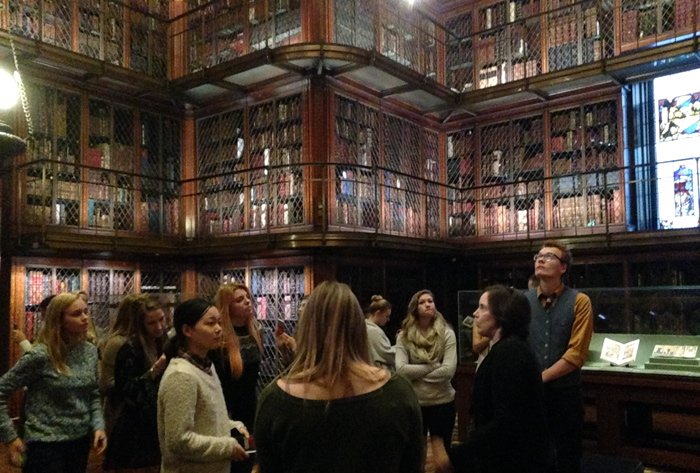At the Morgan

Dickinson students got a tour of J.P. Morgan's original library, now part of the Morgan Library and Museum, from Christine Nelson ’85 (right), the Morgan’s Drue Heinz curator of literary and historical manuscripts. "I feel like the library visit was a uniquely Dickinson experience, because it was so unusual but so special at the same time," says Lexie Wiggins '20. "It shows just how passionate Dickinson academics can help you become, because there are so many amazing opportunities like this trip available."
Students enjoy rare, behind-the-scenes look at Charlotte Brontë exhibit, courtesy of alumna
by Tony Moore
Charlotte Brontë was born in 1816, and to celebrate her birth’s 200th anniversary, the Morgan Library and Museum held a landmark exhibition featuring a portion of the original Jane Eyre manuscript, among many other special items. And a group of Dickinson students was treated to a guided tour, courtesy of Christine Nelson ’85, the Morgan’s Drue Heinz curator of literary and historical manuscripts.
The experience
“It was an amazing experience to be guided through an exhibit by the curator and to understand why everything was put where it was and why she decided to focus on presenting this rather than this,” says Alex Leff ’19 (English), noting that the trip also marked her first visit to New York City. “It made me wish I could go back to every other museum I’ve been to and be walked through by the curator, because I think I would have gained a lot more from those experiences.”
Leff was part of a group of students from Professor of English Wendy Moffat’s English 101 and 220 classes and Assistant Professor of English Sarah Kersh’s 300-level Victorian Sexualities class. And Moffat herself was equally impressed with the experience.
“I don’t think you can get what we got any other way than being there,” says Moffat, who was Nelson’s professor the first year Moffat was at Dickinson. “There’s an ineffable quality, almost like being at a performance, where you’re in a dedicated space and it deepens and personalizes and interconnects senses of what the meaning of something is.”
Literary objects
In that dedicated space were items visitors will likely never see again, such as a blue floral dress Brontë wore, the only two portraits of Brontë done in her lifetime, miniature books Brontë created with her sisters as a child and the author’s portable writing desk. As for the portion of the original Jane Eyre manuscript, on loan from the British Library, the Morgan exhibition was the first time it had been shown in the U.S.
“There’s an atavistic quality to this,” says Moffat. “You’re looking at something that Brontë touched, and it appeals to the fan in me, to the person who adores writers and venerates them in a certain way.”
Emma Batchelder ’17 (biochemistry & molecular biology) found inspiration the moment the group entered the exhibition, when she saw this Brontë quote on the wall:
“To you I am neither man nor woman. I come before you as an author only. It is the sole standard by which you have a right to judge me—the sole ground on which I accept your judgment.”
“It’s really interesting to consider the historical role of various groups of women and to see how those roles are similar or dissimilar to those that hold today,” she says. “I’m strongly interested in women pushing the boundaries in their respective fields, [and] Brontë went against the grain and pushed others to view her not for her sex but rather for her work.”
For both her words and stances, Brontë has been studied, parsed and admired by generations of readers. But in the end, her influence and longevity are born of an even wider confluence of elements.
“Charlotte Brontë, in her time, in and of itself, really embodied the liberal-arts experience at Dickinson, as we discussed and connected topics of race, gender, sexuality, class, etc. in history to literature and to our time,” Batchelder says. “The Morgan Library trip enhanced this experience by allowing for one more connection.”
Learn more
Published January 23, 2017